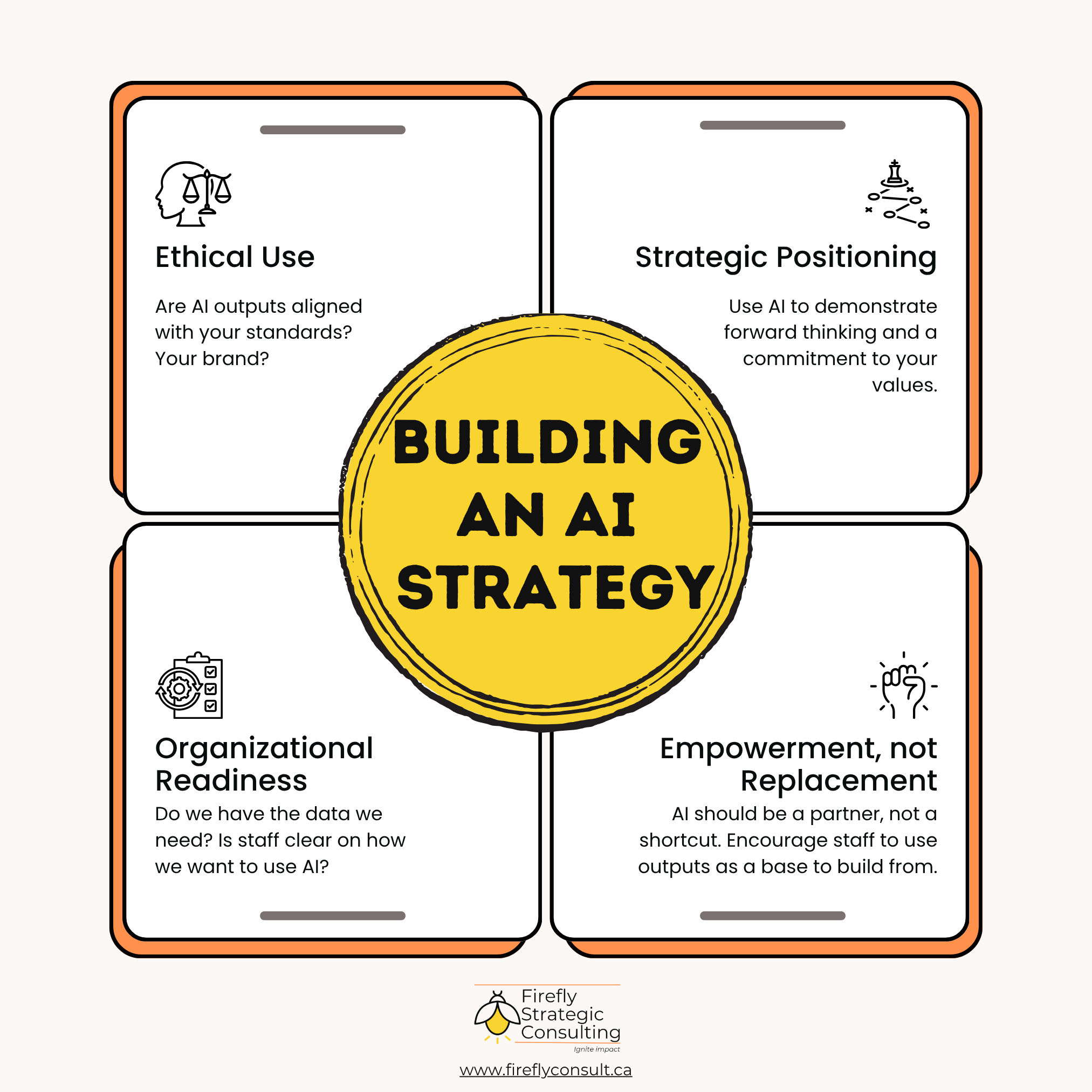Building your AI Strategy with Intention
Why This Matters Now
In my work helping organizations reset and realign how they operate, I talk a lot about the importance of intentional systems, not just the tools we use, but how they connect to our goals, values, and ways of working. AI is the latest addition to that system, and it’s a powerful one. But like any tool, its impact depends on how thoughtfully we choose to use it. This article is about what that looks like in practice, especially for leaders who want to integrate AI without losing the human core of their work.
My own hesitation
I’ve always been a productivity nerd. I love exploring how new tools, systems, shortcuts and other hacks can make a process work better. There’s a particular kind of satisfaction that comes from knowing a task is being completed without having to do the steps yourself - think of the (privileged) satisfaction of having the dishwasher, laundry machine and robot vacuum all going at once… I told you, nerdy.
So when AI started to become mainstream a few years ago, one would have thought I’d be all over it. Yes, I saw the potential, saved time, streamlined tasks, new capabilities, but I didn’t jump on the AI train right away.
Frankly, it felt like yet another tool to learn, and worse, something I’d have to ask my already tired team to adopt.
On top of that was the fear of automating too much. I was nervous that AI would somehow water down the amazing knowledge and creativity the team had built up. Would all work product start to become bland? How would we continue to show our value as an organization?
So I delayed it.
The Shift in Thinking
Many leaders are in the same headspace, grappling with how they want AI to work for them and their organization. Employees are no doubt already using AI tools for their daily work, and that’s a good thing. It shows initiative and a commitment to working efficiently. The challenge is that many are using AI without any organizational guidelines or framework that intentionally align AI use with your mission and values.
My aha moment came when I realized: AI isn’t just about efficiency, it’s about elevating the human side of work.
AI is more than just a productivity tool. It’s a skill booster. It can help us write, design, analyze, strategize… even code. It’s like having a whole shop full of skilled collaborators who can do the time-consuming manual tasks for you, freeing up your time for the creative and strategic work you actually enjoy.
It’s not simply about making our tasks easier or quicker. AI is intended to help us be able to focus on what we want to do, to use our time more wisely. And in a world constantly bogged down by emails, meetings and to-do lists, this should offer a glimmer of hope.
As I learn more, I’ve started thinking less about the technology itself and more about how we humanize AI. Not by giving it a name or a face, but by using it to amplify our values, our goals, and the parts of work that matter most.
What Leaders Need to Know
This starts with ensuring your team has a clear organizational strategy, an ethical framework, and some basic training on how AI should and shouldn’t be used. This is the kind of shift that belongs in the boardroom, not just the IT department. It’s about rethinking how we work, and why we work, in a way that’s grounded, strategic, and human.
Here’s what I’m seeing as key considerations for leaders who want to move their AI strategy forward:
⚖️ Ethical Use AI can generate fast results, but are they aligned with your standards? Your brand voice? Your mission? Building a framework for responsible use helps keep the work human-led and human-centric.
🔍 Strategic Positioning Strategic use of AI can be a signal to your stakeholders. Using it well shows your organization is forward-thinking, values-driven, and committed to quality.
🧠 Organizational Readiness Before diving in, ask: Do we have the right data? Are our teams clear on what “good” looks like? Are we ready to shape prompts that reflect our goals and values?
💡 Empowerment, Not Replacement AI should help you and your team do more of what they’re great at, not feel replaced. Encourage them to use it as a creative partner, not a shortcut. AI outputs are a great starting point, but the real value comes from human input layered on top.
Taking the First Step
You don’t need a full implementation plan to begin. Start small, ask your AI to take notes in a meeting, summarize a report, or revise a draft. You’ll quickly see both the benefits and the limitations, which will help you shape a more intentional strategy.
Try it yourself. Stay curious. Keep your values front and centre.
If you’re exploring AI use in your organization, I’d love to hear what’s working, and what’s still unclear.

